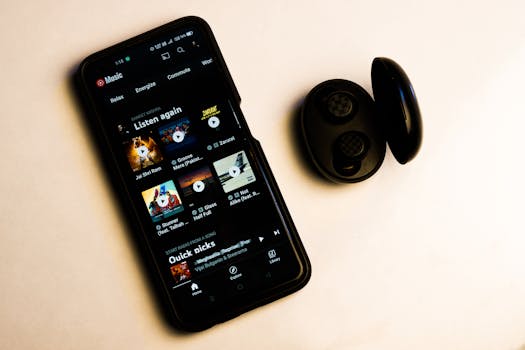Wellness
Digital Journaling Apps for Emotional Balance: A Wellness Guide for Daily Life
Explore how digital journaling apps help you create steady emotional balance with targeted prompts, mood tracking, and easy routines for lasting wellness and self-awareness every day.
Advertisement
There’s a quiet power in writing honest thoughts at the end of the day, like releasing built-up pressure from a shaken soda bottle. When that practice turns digital, it starts to fit into even the busiest routines—especially with digital journaling apps nudging reflection right from our phones. People are realizing that small, regular check-ins with themselves can make a big difference in emotional resilience and stability.
Choosing the right way to capture and process stress or gratitude helps moods and attitudes shift, sometimes overnight. Emotional wellness matters for personal growth and quality of life, as well as for productivity and relationships—making the search for effective self-care tools a priority. Digital journaling apps offer structure, prompts, reminders, and privacy, turning reflection from wishful thinking into an actionable, rewarding habit.
If you want real results—like feeling calmer, more self-aware, and better able to bounce back from a hard day—read on. This article will walk you through practical uses for digital journaling apps and equip you with scenarios, checklists, and patterns that suit real daily life, not just theory.
Building a Personalized Journaling Routine for Steady Calm
Establishing a predictable journaling routine unlocks the steady emotional balance many people seek. Done right, it will fit seamlessly into any day.
The first step is experimenting with timing, prompts, and app features. It’s worth seeing what sparks the most insight—morning gratitude, after-lunch check-ins, or nighttime reflections—within various digital journaling apps.
Choosing a Consistent Time that Matches Your Rhythm
People who journal at the same time each day, even for five minutes, develop stronger habits and collect more authentic emotional data. Select a window of calm—right after waking, before bed, or while commuting—and set an app notification for that slot.
For example, one person might tie their journaling practice to their evening tea ritual. Repeating this cue builds an unconscious association, so grabbing their device becomes automatic, just like brushing their teeth before sleep.
If your schedule feels chaotic, try micro-journaling for two minutes during a predictable lull, such as waiting in line or between Zoom calls. Apps that allow for voice notes or quick touch inputs make this easier than ever, and you’ll capture a more honest emotional snapshot.
Selecting Prompt Types That Actually Trigger Reflection
Simply staring at a digital journal’s blank page rarely leads to the strongest results. Look for apps that offer varied prompts aligned to specific states—gratitude, stress processing, or forward-looking intentions—so you don’t default to shallow observations.
A good prompt might be: “Describe a small win today that felt bigger upon reflection.” Compare how your mood shifts from writing about specifics versus vague ideas. Noticing that shift helps solidify the connection between self-reflection and emotional balance.
Try rotating prompts every few days: gratitude on Mondays, vulnerability on Wednesdays, achievements on Fridays. This keeps the process fresh and encourages different modes of emotional processing within your digital journaling apps routine.
| App Name | Best Feature | Integrations | Takeaway Action |
|---|---|---|---|
| Journey | Clean interface | Google Drive, Markdown | Export entries weekly for a clarity boost |
| Day One | Rich media support | Photos, Location | Add one photo per day to strengthen recall |
| Reflectly | AI-powered prompts | Apple Health, Instagram | Try AI prompts for surprise insights |
| Penzu | Privacy controls | Cloud sync | Lock your journal for peace of mind |
| Diaro | Tagging & Search | Dropbox | Organize entries with emotion tags |
Using Mood Tracking to Reveal and Address Patterns
Spotting mood patterns allows you to anticipate emotional swings and prepare healthy responses. Revisit your digital journaling apps and look for built-in mood tracking features that provide gentle accountability.
Color-coded charts and keyword tracking build self-awareness without requiring extra willpower or complex analysis.
Combining Written Reflection with Mood Ratings
Pairing mood scores with daily reflections helps identify triggers. For instance, after rating a day as “tense,” you might notice the same stressor—like back-to-back meetings—appears in your narrative throughout the week.
Once the connection is clear, plan a swap: “If I notice anxiety at lunchtime, I’ll take a five-minute walk instead of scrolling social media.” These micro-adjustments, practiced with digital journaling apps, gradually raise your baseline mood.
- Set a daily reminder to log your emotional state; this adds consistency and reduces forgotten entries.
- Use short descriptors along with ratings, such as “rushed morning” or “shared a laugh,” to anchor feelings in real events.
- Review trends every Sunday; look for repeating words or color streaks and match them to actual calendar events.
- Jot a single sentence about a low mood day to avoid spiraling—acknowledgment, not rumination, is the goal.
- Compare entries month by month, flagging positive or negative streaks to set realistic self-care goals for the next month.
Tracking mood with context, not just numbers, leads to meaningful insights and incremental emotional shifts over time.
Turning Data Into Actionable Self-Compassion
Instead of judging yourself for dips in mood, treat the gathered data as a weather report—something to dress for, not to blame. Ask, “What’s the smallest adjustment I can try tomorrow?” then log the outcome.
- List potential coping actions, such as breathing exercises, music, or texting a friend, and attach them to frequent triggers found in your journal.
- Build self-compassion by rewriting harsh self-talk in your entries as if encouraging a friend instead.
- Test one change per week, documenting results without criticism. Celebrate the process of adaptation rather than forcing fast improvement.
- Remind yourself that no pattern is fixed—digital journaling apps let you track and gently steer your emotional weather, not control it absolutely.
- End each week with one positive reflection, reinforcing your ability to grow emotionally just as you track your mood’s ebbs and flows.
Plugging these small changes into your digital journaling routine will eventually add up to greater self-kindness and balance.
Prompts and Routines for Different Stress Levels
Tailoring prompts and journaling habits to match your energy and mood ensures you get value from digital journaling apps, regardless of how your day unfolds.
On calm days, prompts that encourage future planning or gratitude spark motivation. On hard days, focus on self-soothing, reframing, or acceptance cues to gently ground yourself.
Quick Prompts for High-Stress Moments
During tough patches, the right phrasing makes it easier to write—even if your mind feels scattered. Instead of open-ended questions, use focused cues: “Finish the sentence: ‘Right now, my breath feels…’”
Another script could be, “List three safe places in your life.” These practical, concrete prompts make digital journaling apps especially useful when stress peaks and emotional resources are low.
Writing something, even a phrase or two, diffuses pressure. Later, reviewing these honest notes will reveal growth, not just hard days.
Deeper Reflections When Emotional Space Allows
In periods of calm, prompts such as, “Describe a time I handled a challenge well,” or, “What small thing brought delight today?” deepen self-awareness.
If you’re savoring quiet, write longer entries about subtle shifts or unexpected joys. Compare these with your higher-stress notes later—this contrast builds perspective and self-trust, key ingredients for balance.
Digital journaling apps let you adjust—using quick notes in rough patches and reflective essays when calm—making your routine sustainable.
Outlining App Features That Boost Emotional Insight
Specific features built into digital journaling apps can speed up personal growth by converting feelings into patterns and plans. Knowing what to activate upfront maximizes your practice.
Check what each app offers and imagine, “Would this save me clicks, boost privacy, or spark new thoughts?” Pick two features that really matter—and use them, not just admire them.
Voice Notes and Speech-to-Text for On-the-Go Journaling
Voice recording lets you capture fleeting thoughts during commutes or walks, making it easier to describe emotions in the moment. This authentic self-narration feels natural—many people express feelings out loud more clearly than in writing.
Speech-to-text turns those ramblings into searchable notes. Think, “I feel tightness in my shoulders after work,” and speak it aloud. The entry’s immediacy provides richer trends to reflect on later.
Pair quick audio or speech entries with evening text reviews to reinforce honesty and boost recall, especially as part of daily unwinding rituals.
Automation and Tagging for Context and Trends
Automated reminders make journaling a non-negotiable anchor in the day, minimizing forgetfulness and guilt. Tags split entries by event, mood, or topic—making it easy to repeat what works or avoid common pitfalls.
If a tag like “conflict” shows up three times in a week, review those entries on Sundays for new responses. Use “celebration” tags to create an instant highlight reel on hard days.
Automation and tagging combine efficiency with insight, allowing digital journaling apps to serve as both emotional barometers and cheerleaders through your ups and downs.
Blending Daily Micro-Journaling with Weekly Deep Dives
Short, daily micro-journaling builds reliable self-knowledge, while longer weekly reviews reveal trends and pave the way for reflection and change. Blending both approaches offers the strongest support for emotional balance.
This dual habit ensures you capture fleeting thoughts before they vanish while building space for big-picture analysis that drives growth.
Micro-Journaling Practices for Momentum
Jot down a “headline” for your emotion or day using a digital journaling app. For example, “Felt unseen at work, but had a relaxing walk home.” This gives context without pressure to write a full narrative.
Set a two-minute timer. Write, speak, or record one key feeling or event, then stop. This structure means journaling happens even on busy, stressful days, anchoring the habit.
Micro-journaling prevents buildup of unresolved emotions, which can otherwise surface unexpectedly or distort weekly reviews. Treat quick entries as emotional breadcrumbs to revisit later.
Weekly Reflection Rituals for Learning and Adjustment
Choose a consistent slot, like Sunday evening, to review the past week’s entries and tags in your app. Mark entries that trigger pride, growth, frustration, or patterns you want to address.
Summarize what worked and what didn’t, then note one or two experiments for the coming week: “Take a breath before replying to work emails” or “Journal gratitude images instead of words.”
Weekly reviews maximize the payoff from daily micro-journaling, converting scattered moments into actionable insights that boost ongoing balance and well-being.
Conclusion: Sustained Emotional Balance Is Built on Small, Consistent Steps
Emotional wellness doesn’t hinge on grand gestures but on regular, honest check-ins using digital journaling apps. What matters is the pattern you set—showing up for yourself in little moments, collecting small wins and lessons over time.
Viewing emotional health as a process, not a destination, keeps pressure off and builds resilience. Digital journaling apps provide flexible, friendly scaffolding for the habits that stabilize mood, sharpen insight, and cultivate meaningful growth.
When you anchor your days with simple journaling, you’re better equipped to respond with curiosity, bounce back from setbacks, and appreciate your own progress—one candid entry at a time.
Trending Topics

How to Improve Sleep Hygiene with Mobile Tools
Strengthen your sleep hygiene with mobile tools that manage bedtime habits and improve nightly rest quality.
Keep Reading



